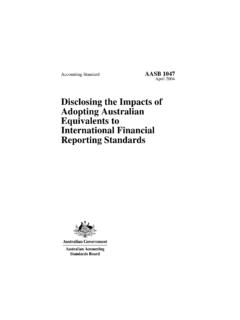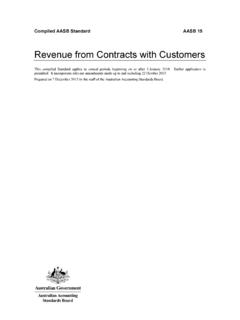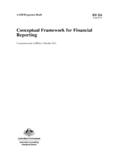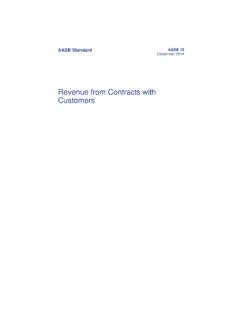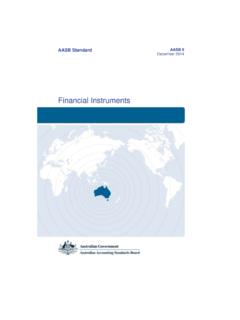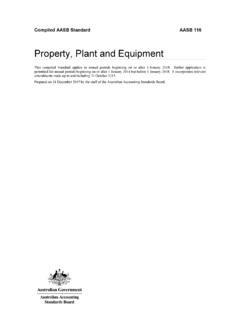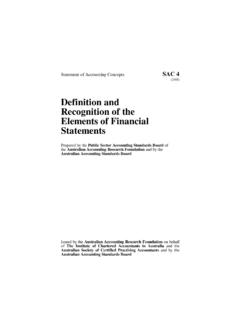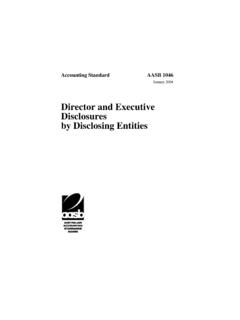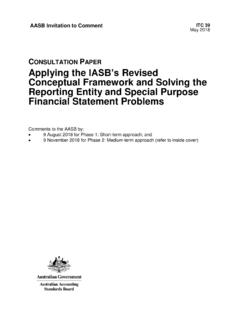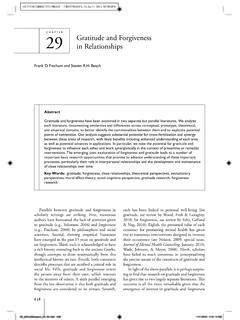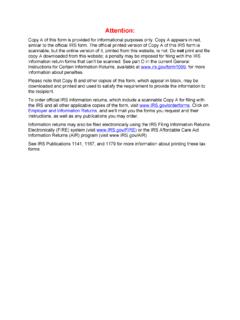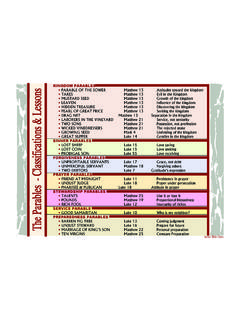Transcription of Set-off and Extinguishment of Debt
1 Accounting StandardAASB 1014 December 1996 Set-off andExtinguishment of DebtIssued by theAustralian Accounting Standards BoardAASB 10142 Obtaining a Copy of this Accounting StandardCopies of this Standard are available for purchase from the AustralianAccounting Standards Board by contacting:The Customer Service OfficerAustralian Accounting Research Foundation211 Hawthorn RoadCaulfield Victoria 3162 AUSTRALIAP hone:(03) 9523 8111 Fax:(03) 9523 1996 Australian Accounting Standards Board. The copying of thisStandard is only permitted in certain circumstances. Enquiries should bedirected to the Australian Accounting Standards 1036-4803 AASB 10143 CONTENTSCONTENTSMAIN FEATURES OF THE STANDARD .. page 4 Section and page number1 Application .. 52 Operative Date .. 53 Purpose of Standard .. 64 Extinguishment of debt .
2 6 Extinguishment .. 7 Defeasance .. 7In-Substance Defeasance .. 8 Instantaneous In-Substance Defeasance .. 8 Consolidation Adjustments .. 9 Treatment of Defeasance when ConditionsNo Longer Met .. 9 Partial Extinguishment .. 105 Costs of Defeasance .. 116 Gains and Losses on Defeasance of debt .. 117 Disclosures .. 128 Comparative Information .. 139 Set-off of Assets and Liabilities .. 1310 Transitional Provisions .. 1611 Definitions .. 16 CONFORMITY WITH INTERNATIONAL AND NEWZEALAND ACCOUNTING STANDARDS .. page 20 BACKGROUND TO REVISION .. page 22 Defined words appear in italics the first time they appear in asection. The definitions are in Section 11. Standards are printedin bold type and commentary in light 10144 FEATURESMAIN FEATURES OF THE STANDARDThe Standard:(a)requires debt to be accounted for as extinguished when settledthrough repayment or replacement by another liability(b)prescribes the conditions to be met before a debt can be accountedfor as having been extinguished in the following circumstances.
3 (i)legal defeasance(ii)in-substance defeasance via a trust(iii)in-substance defeasance via assumption by a risk-freeentity(c)prescribes the accounting required when the conditions forextinguishment cease to be met(d)prescribes the accounting for partial extinguishments(e)explains the application of the defeasance conditions in the contextof consolidated financial reports(f)prescribes the accounting for costs of defeasance and gains andlosses on defeasance(g)prescribes specific disclosures concerning defeasances and defeaseddebt(h)requires assets and liabilities to be set off in the presentation of thebalance sheet when:(i)there is a legal right of Set-off ; and(ii)the entity intends to settle the asset and the liability on anet basis or 10145 STANDARDAASB 1014 " Set-off ANDEXTINGUISHMENT OF debt " to paragraph , this Standard applies to each entitywhich is required to prepare financial statements in accordancewith Part of the Corporations Law and which:(a)is a reporting entity; or(b)holds those financial statements out to be, or form partof, a general purpose financial a requirement of this Standard is inconsistent with anyprovision of the Corporations Law or the CorporationsRegulations, the requirement does not standards specified in this Standard apply to the financialreport where information resulting from their application ismaterial, in accordance with Accounting Standard AASB 1031"Materiality".
4 2 Operative Standard applies to financial years ending on or after 31 December Standard may be applied to financial years ending before31 December 1997 where an election has been made inaccordance with subsection 285(3) of the Corporations operative, this Standard supersedes Accounting StandardAASB 1014 " Set-off and Extinguishment of debt " as approvedby notice published in Gazette No. S 156 on 20 June 1990 andamended by Accounting Standard AASB 1025 "Application ofthe Reporting Entity Concept and Other Amendments". of this Standard was published in the Commonwealth ofAustralia Gazette on 12 December 10146 of purpose of this Standard is to:(a)specify when a debt is to be accounted for as havingbeen extinguished, including by way of defeasance(b)prescribe the method of accounting for theextinguishment of debt , including by way of defeasance(c)establish criteria for the Set-off of assets and liabilitiesin the presentation of the balance sheet which do notoverrule specific requirements of other AASBA ccounting Standards(d)require disclosure in the financial report of informationrelating to the defeasance of Standard does not establish criteria for determining whethertransactions or events should be accounted for as separate assetsand liabilities.
5 In relation to the Set-off provisions, it is concernedonly with preventing the omission of assets and liabilities from theface of the balance sheet by means of Set-off where no right of Set-off exists. The Standard does not therefore establish whethertransactions such as cross-currency and interest-rate swaps, foreigncurrency forward exchange agreements and leveraged leases giverise to separate assets and of debt must be accounted for as having been extinguished when,and only when, it has been:(a)settled through repayment or replacement by anotherliability; or(b)subject to a legal defeasance which meets the conditionsset out in paragraph ; or(c)subject to an in-substance defeasance employing a trustwhich meets the conditions set out in paragraphs ; or(d)subject to an in-substance defeasance in which a risk-free entity assumes responsibility for the servicingAASB 10147 (both interest and principal) of the debtin a manner which meets the conditions set out inparagraph a debt to be accounted for as having been extinguishedthrough a legal defeasance or an in-substance defeasance, it is acondition that it is highly improbable that the entity will berequired to assume again the primary obligation for the debtservicing requirements (interest or principal) or to satisfy anyguarantee, indemnity or the like relating to such conditions to be met before a debt is accounted for ashaving been extinguished through an in-substance defeasanceemploying a trust include.
6 (a)risk-free assets are irrevocably transferred to a trust,the trustees of which are independent, and remainindependent, of the entity, and which trust is used solelyfor administering those assets so as to meet the servicingrequirements (both interest and principal) of the debt ;and(b)the assets transferred to the trust are of an amount andtype suited to the amount and timing of the servicingrequirements (both interest and principal) of the in the definition of a liability specified in paragraph isthat a debt ought to be removed from the balance sheet when it hasbeen extinguished. The liability of a debtor for a debt may beextinguished in a number of ways:(a)by settlement through repayment or replacement byanother debt ; or(b)through legal defeasance, including forgiveness,assumption by a third party or legal judgement; or(c)through an in-substance defined in paragraph , defeasance means the release of adebtor from the primary obligation for a debt .
7 A legal defeasanceAASB 10148 take place in absolute terms, that is, the debt could cease toexist for anyone (by being forgiven or set aside), or the creditorAASB 10149 formally recognise that another party has taken over theprimary obligation for the release of a debtor from the primary obligation for a debt mayalso be achieved "in substance" by the debtor, either by transferringto a trust assets which are adequate to meet the servicingrequirements (both interest and principal) of the debt and arededicated to that purpose, or by having a suitable entity assumeresponsibility for those servicing requirements. Under thisStandard, in-substance defeasance is subject to strict conditionsbefore the liability involved can be considered extinguished foraccounting purposes and removed from the balance conditions required by this Standard to be met before a debtcan be considered extinguished for accounting purposes through anin-substance defeasance which employs a trust include theirrevocable transfer of risk-free assets to a trust.
8 Risk-free assetsare, as defined in paragraph , limited to cash, or securities of acreditworthy government or of a body guaranteed under statute by acreditworthy government, which are denominated in the samecurrency as the debt being defeased. The reference to cash in thedefinition of risk-free assets includes currency and cash at bank. Itdoes not include any form of term investment account with a bank,unless that account qualifies specifically as a government-guaranteed security. It also does not include variable-rate securitiesunless the variable rate matches the rate on the debt being is expected that cash would be held by a trust that qualifies underthis Standard only for the purposes of acquiring government-guaranteed securities, for meeting debt servicing requirements orfor meeting the costs of administering the trust.
9 The strictness ofthe definition of risk-free assets is required if a debtor is to be leftvirtually in the same position, in terms of risk, after an in-substancedefeasance as would apply if the debt had in fact been settled orlegally In-Substance is sometimes argued that there should be a prohibition on theremoval of debt from the balance sheet where that debt is expresslyincurred for the purpose of immediate or near immediateinvestment in higher yielding securities to be held by a trust in themanner set out above for an in-substance defeasance; that is, thataccounting for an in-substance defeasance as an extinguishmentwhen that defeasance is "instantaneous" should be prohibited. It isAASB 101410 that, in these circumstances, the principal purpose of thetransaction is to borrow and invest to achieve benefits from interestrate differentials,AASB 101411 than to extinguish existing debt .
10 There is usually noopposition to a legal "instantaneous" defeasance being accountedfor as an Standard requires the removal of debt from the balance sheetof the debtor when the primary obligation of the debtor has beendischarged or the debtor has been placed in virtually the sameposition as if the debt had been discharged. Although it is possibleto distinguish the circumstances of a normal in-substancedefeasance from those of an instantaneous in-substance defeasance,it may not be possible to distinguish the position of the debtor interms of subsequent lack of primary obligation. Accordingly, thisStandard requires accounting for an instantaneous in-substancedefeasance as an Extinguishment , provided that the conditionsreferred to in paragraph for an in-substance defeasance are accounting by a subsidiary for the Extinguishment of a debtthrough a defeasance needs to be reversed for the consolidatedfinancial report if the defeasance conditions are not met in relationto another entity in the economic entity.
